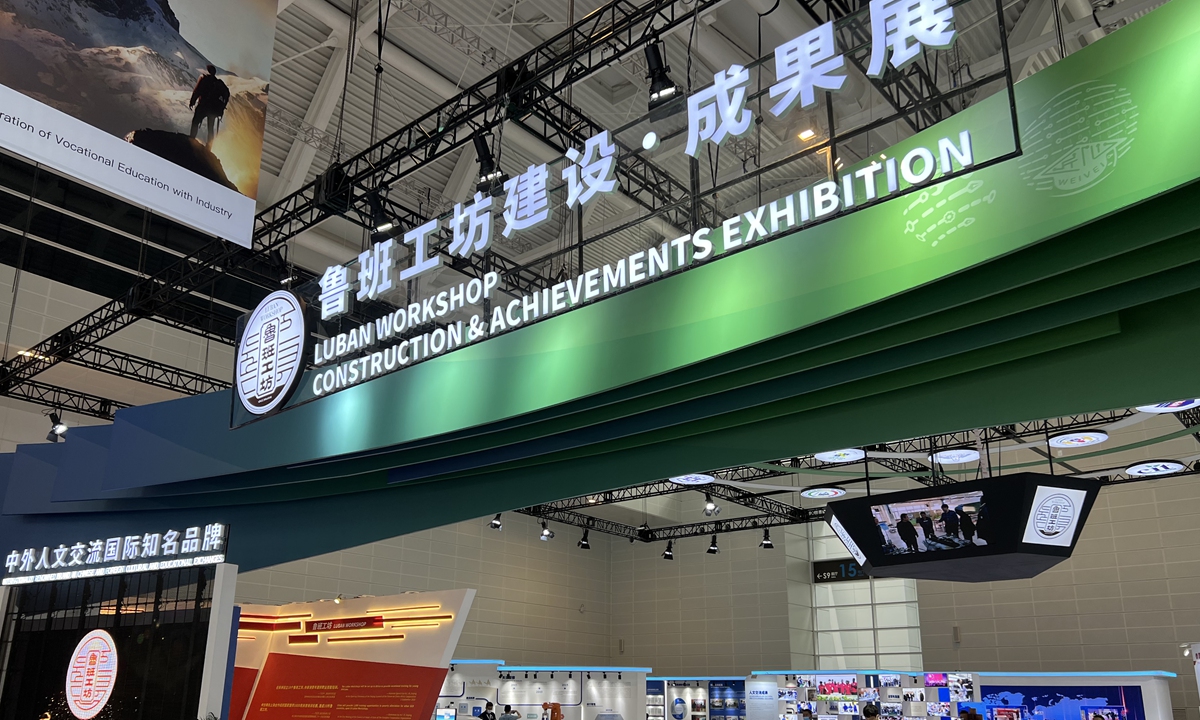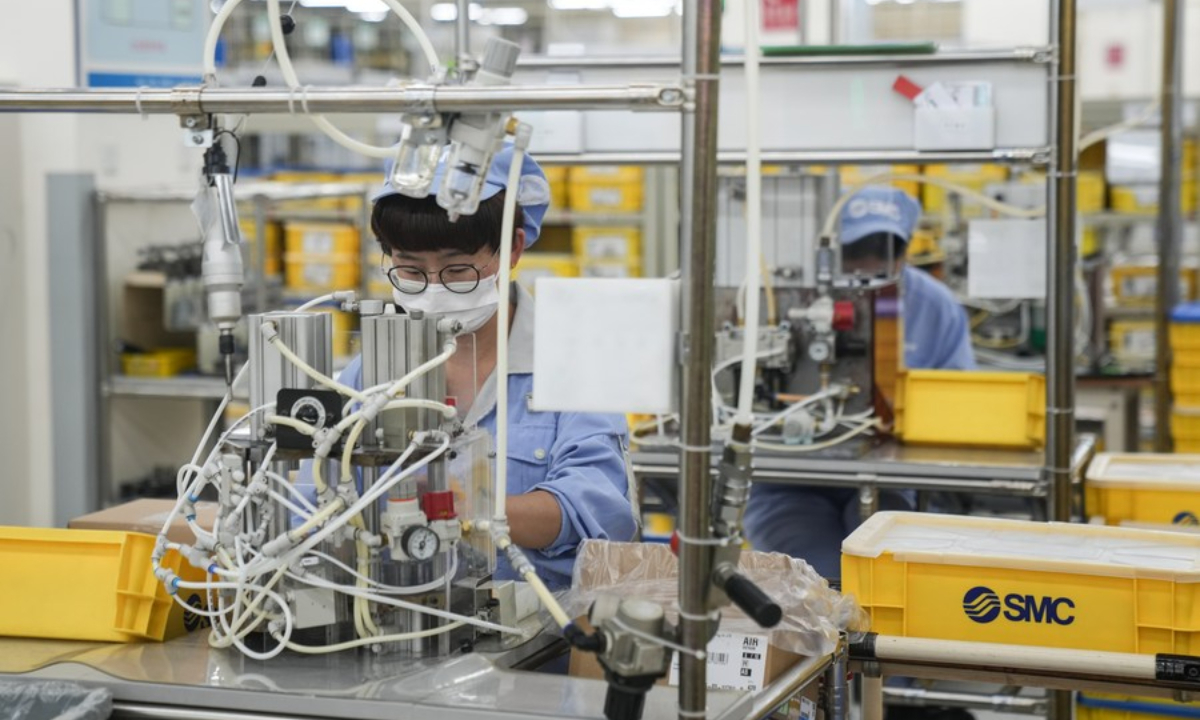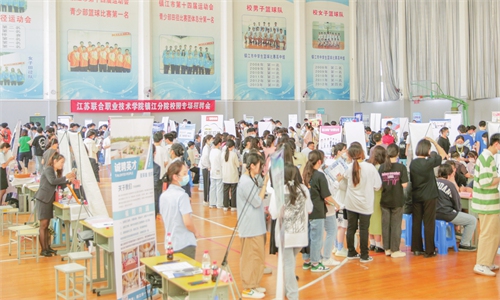China thirsty for skilled workers amid industrial upgrade, tech self-sufficiency
Role of vocational education stressed at Tianjin event

A view of the World Vocational and Technical Education Development Conference in North China's Tianjin Municipality on Friday. Photo: Li Xuanmin/GT
Vocational education has great significance for promoting employment and entrepreneurship, boosting economic and social development, and China actively pushes forward the high-quality development of vocational education, and supports exchanges and cooperation in vocational education with other countries, Chinese President Xi Jinping said in a congratulatory letter to the World Vocational and Technical Education Development Conference on Friday, the first such event of its kind, which is being held in North China's Tianjin Municipality.
Xi's words underscored the great emphasis China puts on vocational education, as the world's largest manufacturing powerhouse - with a technical talent pool gap estimated to reach 30 million by 2025 - is thirsty for skilled workers and technical personnel in emerging high-tech sectors ranging from robots and artificial intelligence to new energy, amid pushes for industrial upgrading and technical self-sufficiency, participants said.
As China is facing labor market strains, vocational education is set to play an outsized role in easing the job market mismatches that partly fuel "structural unemployment," while also funneling more opportunities to young job-seekers. Observers said that in the long term, vocational and academic education could achieve synergies, creating a multi-layered workforce that fires the world's second-largest economy on all cylinders.
The Chinese side stands ready to work with other countries in the world to strengthen mutual learning, joint contribution and shared benefits, join hands to implement the Global Development Initiative, and contribute to accelerating the implementation of the UN 2030 Agenda for Sustainable Development, Xi said in the letter, which was read by Chinese Vice Premier Sun Chunlan via a videolink at the conference's opening ceremony.
"Vocational education is the most efficient and direct way of nurturing high-quality skilled talent, and is conducive to improving the quality and configuration of production factors, contributing to a world economic recovery," Sun said, noting that through such education, students also expand their career prospects and improve their abilities.
There has been a "drastic increase" in the need for skilled labor in recent years and such enterprise-level demand is "unprecedented," particularly in sectors concerning intelligent manufacturing, such as industrial robots, intelligent equipment-making and aviation, Wang Weiyuan, the vice president of the Tianjin Vocational College of Mechanics and Electricity (TVCME), told the Global Times on Friday on the sidelines of the conference.
"Such a shift is in line with China's position as a strong global manufacturing base and how the Chinese economy will propel itself going forward. Chinese society is in urgent need of high-quality professional workers," Wang explained, adding that the employment rate of the school's 4,000 graduates has exceeded 90 percent this year, and a host of students even signed employment contracts before graduation.

Staff members work at a factory of SMC Corporation in Beijing Economic-Technological Development Area of Beijing, capital of China, June 4, 2022. Photo:Xinhua
The Global Times learned from other vocational colleges in Tianjin that an above-90-percent employment rate is "quite common," and some new, red-hot majors have seen a 100-percent employment rate.
Enterprises have achieved cooperation with many schools and set up special classes starting with the junior year to nurture targeted talent - a model called "order-form teaching."
TVCME has signed model contracts with a number of firms such as Mercedes-Benz's Beijing plant, and students under the "order-form teaching" model accounted for 70 percent of its graduates this year.
Other companies on the list of partnerships with Tianjin vocational schools include robotics firm Siasun Robotics, Qilin Software - which develops homegrown operation systems - and big data firm Inspur.
The hot vocational job market in Tianjin, where manufacturing accounts for about half of the economy, epitomizes how demands for what traditional known as "blue-collar" workers have been shooting up in recent years at the national level.
According to a report jointly issued by the Ministry of Human Resources and Social Security and Ministry of Industry and Information Technology, the gap in skilled workers among China's 10 major manufacturing sectors has exceeded 19 million, and such vacancies are estimated to reach 30 million in 2025, translating to a gap of 48 percent.
"We're not talking about blue-collar workers, or the 'screws' in flow line production in traditional terms. What China's manufacturing upgrade needs is not migrant workers without any entry threshold. To be qualified for new kinds of jobs, you need to be professionally trained, innovation-oriented and hold a lot of certificates," Qi Yuming, deputy dean of the Institute of Robotics and Intelligent Equipment under Tianjin University of Technology and Education, told the Global Times on Friday.
China has the world's largest vocational education system with 11,300 such schools teaching more than 30 million students, data from the Ministry of Education showed.
Cong Yi, a professor at the Tianjin University of Finance and Economics, told the Global Times on Friday that ensuring the development of vocational education is of critical importance in terms of cementing China's manufacturing edge and advanced industrialization geared toward automation and intelligence.
"We should not compromise our advantage in fierce global technology competition," said Cong.
Observers believe that undersupply in the booming vocational job market could alleviate rising pressures on China's employment, to some extent.
In July, the surveyed urban unemployment rate dropped to 5.4 percent, falling for a third consecutive month. Yet the youth (aged 15-24) jobless rate hit a record high of 19.9 percent in July as 10.76 million new college graduates entered the workforce, the first time the number exceeded 10 million.
"The jobless rate is partly caused by structural unemployment, meaning there are mismatches among skilled labor, university graduates and market demand. An effective solution is to scale up vocational training, and draw more students to vocational enrollment," Cong said. He added that this calls for both a shift in students' views on occupational choice and tailored government policy support.
On May 1, the revised Vocational Education Law came into force, which clearly states that vocational education in China is equally important as general education, and that China encourages the development of a variety of forms of vocational education, the Xinhua News Agency reported.
Multiple Chinese manufacturing bases have also announced muscular policies encouraging the innovative development of vocational education.
"With vocational education set to amass a group of skilled labor, China in the long term will develop a multi-layered pool of talent from front-line manufacturing to research and development, building ammunition for driving manufacturing prowess," Qi said.


